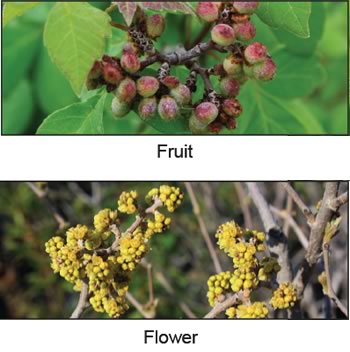Fragrant Sumac
The fragrant sumac has tiny yellow female flowers along branches and flower mid to late March-April. Flowers appear before foliage emerges.
Rhus aromatica aka fragrant sumac is Easily transplanted and adaptable. Useful for quickly covering banks. Performs well in average to clay soils. Salt tolerant. Attracts butterflies, birds and bees. Deer resistant. Great fall colour.
Fragrant Sumac Characteristics
 Leaves: Very attractive tri-leafed foliage is medium green with a blue-green effect. Leaves are glossy above and turn orange, red and reddish purple in the fall.
Leaves: Very attractive tri-leafed foliage is medium green with a blue-green effect. Leaves are glossy above and turn orange, red and reddish purple in the fall.
Stem/Bark: Stems are fragrant when bruised.
Flower: Tiny yellow female flowers along branches mid to late March-April. Flowers appear before foliage emerges.
Fruit/Nut: Bright red, hairy fruit from late summer to late fall on female plants only.
Habit: Dense multi-stemmed deciduous shrub. Tends to sucker from the roots and form large clumps. Low spreading shrub fills in to the ground.
Hardiness: Zone 3
Height: 4’
Width: 6’
Why grow native plants?
A native plant is defined as a species of fauna that was already established before colonization. There are numerous benefits to the use of native plants. Native plants have grown and evolved in a given area for generations and therefore are more prepared to face the elements. As a result they are much hardier and less finicky to care for. The wildlife in the area has also evolved along side these plants, and because of this has formed bonds with them. Most butterflies have a specific plant species from which they collect nectar for their offspring.
There are many birds that will feed directly from local trees for seed, nectar or fruit, but won’t use the bird feeder you’ve bought to attract them. These plants also work together to grow as natural plant communities. Most of the trees won’t grow their leaves until after the wildflowers have had an adequate amount of time to flower before they’re covered by shade. Finally, of course, there is the fact that all of these plants and animals combine to make a sustainable, complete, functioning ecosystem. Why fight thousands of years of evolution?
Have questions about native plants? Post a comment Ian will get back to you.






